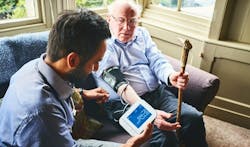Making Connections with IoT Solutions
Download this article in PDF format.
The driving force behind today’s smarter cars, homes, factories, and cities is the myriad of Internet of Things (IoT) devices now in place. They can collect data on almost any physical or environmental parameter, such as pressure, temperature, light intensity, and humidity, and transfer large amounts of data to the internet by means of unlicensed wireless communications bands.
Given the increasing speeds of cellular wireless communications networks such as 4G LTE and the emerging 5G New Radio (NR) high-speed networks, once the data from IoT devices has been stored on “the cloud” of servers connected on the internet, it can be applied almost instantly for monitoring and analysis. In turn, hospitals become safer, production plants are more efficient, and homes and cities become “smarter” and more livable.
Wireless cellular communications may not always be available for interconnection of IoT sensors to the internet and, for that reason, IoT systems function as “networks within a network.” A typical IoT network consists of its remotely located sensors, such as real-time video cameras and smart security sensors that detect motion when an intruder enters a vacated home, and an intelligent gateway that’s wirelessly connected to the sensors.
The gateway has the processing power to run software for applications related to the data being collected by the IoT sensors, such as security monitoring software for the smart home. It also coordinates the communication of the data to a wireless cellular network when available and within range of the gateway. When a cellular network isn’t available or within range, the gateway can be programmed for communications with a user’s computer, smartphone, or other mobile device for monitoring and control.
What Type of Network?
In establishing an interconnected network of IoT devices, the types of things and applications will determine the key parameters of the IoT network, such as whether short- or long-range coverage to the gateway is needed, whether a narrowband or wideband channel is needed for smaller or larger amounts of data, and the power consumption of the IoT network and whether sensors have permanent power available or must run on battery power. IoT devices perform wireless communications to a gateway via license-free industrial, scientific, and medical (ISM) frequency bands, including at 433, 868, and 915 MHz, and 2.4 GHz.
Different ISM-band wireless standards are used to link IoT devices to an IoT gateway, including Bluetooth (based on the IEEE 802.15.1 standard), Zigbee (IEEE 802.15.4), and Wi-Fi (IEEE 802.11). All three operate at 2.4 GHz. Wi-Fi, which is used for many wireless local area networks (WLANs), also works at 5 GHz.
The two-way communications links between an IoT sensor or node and its gateway or server must provide adequate dynamic range (transmit power and receiver sensitivity) to reliably communicate at target data rates and power-consumption levels. But they must also operate without interference from other signals within an often-crowded 2.4-GHz ISM band. For example, an IoT wireless network based on Zigbee must withstand interference from Bluetooth signals within the same band, whether from fixed or mobile wireless devices.
For many IoT applications, low-power operation is an important consideration. To that end, LoRaWAN—a low-power wireless wide-area-network (WAN) LoRa technology developed by Semtech—has been adopted for many IoT devices and gateways to save power. Battery-powered nodes or sensors uplink or transmit data to a gateway or server and downlink or receive instructions from a gateway only at certain times to conserve power, in contrast to more power-hungry sensors that may remain in constant receive mode with a gateway.
LoRaWAN IoT technology is based on unlicensed 2.4-GHz ISM spectrum, as well as from 867 to 869 MHz in Europe and 902 to 928 MHz in the U.S. Using spread-spectrum and IEEE 802.15.4g protocols, LoRaWAN IoT devices and gateways use different modulation bandwidths to achieve generous IoT link budgets while remaining compatible with IoT sensors based on conventional modulation formats. Semtech produces gateways and node transmitters, receivers, and transceivers for low-power IoT applications.
Array of Applications
Using LANs that can exchange data between users and things creates almost unlimited opportunities for applying artificial-intelligence (AI) and machine-learning techniques to electronic systems and devices in many different markets. The leading applications for IoT devices and low-power networks are those close to home or right in the home as part of a smart home or building. Such applications allow a building owner to add IoT sensors for security, temperature control, turn lights on and off depending on time of day or occupancy, and even perform remote smart power monitoring to conserve energy by minimizing power use in parts of the home where it’s not needed.
In this type of application, all IoT sensors are wirelessly connected to a gateway in the manner of a WLAN. The gateway is then connected by a service provider to a major communications network by a fiber-optic landline connection or via wireless connection to a 3G, 4G, or 5G cellular wireless communications network. Provided that landline or mobile communications access is available, a user can monitor and modify IoT sensor settings within the smart home at any time.
The initial investment in an IoT gateway and sensor devices is quickly recouped by the energy savings in the smart home. In addition, the IoT setup can be used for other applications within the building. For instance, it could achieve 24-hour home security, not to mention the peace of mind that comes with having full-time electronic security. Or it can offer the ability to remotely and automatically keep track of required maintenance of electronic equipment, such as washers, dryers, and heating equipment, at any time with a mobile communications device such as a smartphone.
Perhaps the most remote application of IoT technology is in national forests and animal preserves, where IoT gateways and sensors are used to remotely track and protect endangered species of animals from unlawful hunting and trapping. Low-power IoT devices are especially needed in such applications to deliver maximum run time and extended reach for the IoT network.
Many of these applications help forest rangers in remote national parks in Africa and South America to thwart attempts by poachers to trap animals within the parks. Because of the remoteness of the parks, there’s typically no access to a global 3G or 4G cellular wireless network; the IoT system must function as a relatively long-range secure wireless communications network. Sensors, such as motion detectors, are distributed throughout the park and its perimeter and interconnected to a network of slave and master gateways to create coverage over a wide area, allowing rangers to monitor for poachers as well as check on the whereabouts of their valued “residents.”
IoT technology is quickly being found to be immensely useful in many different industries, too. For connected cars, it simplifies communications between drivers as well as between drivers and machines. In smart factories, IoT helps track and maintain inventory and improve the efficiency of logistics and supply-chain management. It also enables machine-to-machine (M2M) interconnections—AI and machine learning between machines can help optimize the performance of robotic assembly and manufacturing equipment while monitoring power consumption and increasing power efficiency. In “smart cities,” IoT sensors and networks are providing numerous functions for improved quality of life, including automated vehicular traffic/pedestrian monitoring at traffic intersections.
A Boon to the Medical Field
However, perhaps no industry is experiencing greater benefits from the use of IoT technology than in medical and healthcare applications. AT&T Business, one of the leaders in applying IoT devices and networks throughout different industries, has already connected millions of “smart cars” to the internet by means of its IoT devices and 4G LTE networks. SAS is another leader in the use of IoT technology for medical and healthcare applications, as well as in the use of IoT in many other industries, including smart factories and connected cars.
AT&T Business predicts that 80 billion devices will be connected to the internet in the U.S. via IoT technology by 2025. Other prognosticators have stated that trillions of devices in China alone will be connected to the internet by 2025, creating a need for the increased bandwidth and data speeds possible with 5G cellular wireless networks.
Increased life expectancies are creating a growing number of older retired persons and an associated increasing demand for in-home medical monitoring. Unfortunately, as the number of older potential patients grows, available doctors and healthcare providers are more thinly spread to provide service or even basic checkups to those patients. The application of IoT technology can help by delivering in-home monitoring with IoT-enabled medical devices, such as blood-pressure and heart-rate monitors that a doctor or healthcare professional can access remotely over a 3G, 4G, or 5G cellular network.
AT&T Business has earned a leadership role in its applications for IoT in the home, for smart factories with real-time video monitoring for security, in smart cities, and in connected cars. However, perhaps the most meaningful are medical and healthcare applications in homes, hospitals, and healthcare facilities (Fig. 1).
1. The use of IoT technology may have the greatest benefits in hospitals and healthcare facilities. (Courtesy of AT&T Business)
For example, AT&T Business uses its Astute CTR-01 hub and multiple IoT nodes to provide in-home medical monitoring and connection of medical devices with connection to a 4G LTE network for secure outside access by means of a cellular smartphone. The hub/gateway is compatible with standard wireless-network technologies such as Bluetooth Low Energy (BLE) and Wi-Fi, easing the interconnection of commercial IoT-enabled medical devices such as wearable monitoring devices. The application-programmable-interface (API) software developed for the IoT devices and hub is also compatible with most legacy medical applications, thus simplifying the creation of an in-home medical monitoring system.
IoT technology also helps improve the security and efficiency of medical professionals in hospitals and healthcare facilities, starting with automated patient check-in practices rather than extended paper-based check-in procedures. Furthermore, the technology can be applied in the wireless connection and monitoring of many medical monitors throughout a hospital, while maintaining the cybersecurity of the APIs that drive the IoT gateways connecting the many IoT medical nodes throughout a facility, including heat-rate monitors (Fig. 2).
2. IoT technology will help serve the medical needs of a growing, aging population of retired persons with a shrinking number of medical professionals. (Courtesy of AT&T Business)
Such secure IoT networks also provide instant access for medical professionals to the data from relatively large and sophisticated medical analysis systems. These include computer-tomography (CT) and magnetic-resonance-imaging (MRI) systems (Fig. 3).
3. AT&T Business’s IoMT devices and networks can provide remote access to brain scans performed by CT imaging equipment. (Courtesy of AT&T Business)
AT&T Business’s extensive use of IoT technology for medical applications has prompted the firm’s description of its medical electronic products and services as the Internet of Medical Things (IoMT), which includes its unique Aira service. By using smartphones and smart eyeglasses, the service is aimed at places of business seeking to become more user-friendly for low-vision customers. Businesses subscribing to the Aira service are outfitted with IoT sensors and gateways that provide customers with real-time, enhanced views of the business place. As this one application may indicate, the opportunities for IoT applications are endless and the promises are staggering.




